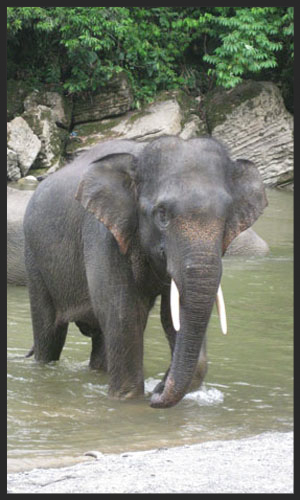A story of collaboration, teamwork, and the paying forward of helping range country vets grow their abilities to help Asian elephants:
In 2014, Asian Elephant Support (AES) funded two veterinarians to educational workshops: Dr. Vanthinh Pham from Vietnam to a workshop in Sri Lanka, and Dr. Khajohnpat Boonprasert (“Dr. Yeaw”), from Thailand, to the EEHV workshop held in the United States. Dr. Yeaw’s trip was funded both by AES and the Golden Triangle Asian Elephant Foundation (GTAEF).
Fast forward to 2015:
On the 19th of February, 2015, a young wild male elephant, since named Jun, was discovered by Yok Don National Park officials. Dr. Vanthinh Pham and his team from the Dak Lak Elephant Conservation Center in Vietnam rescued him with care.
Jun was quite aggressive and Dr. Pham had difficulty effectively treating his moderately infected would that began getting worse. Dr. Pram sought assistance from veterinarians experienced in treating such injuries and as well as help in training Jun with positive reinforcement to allow for safe treatment.
Dr. Khajohnpat Boonprasert (“Dr. Yeaw”), of The Elephant Conservation Center (TECC) in Lampang, Thailand, along with two of their highly experienced mahouts, traveled to Dak Lak Elephant Conservation Center in Vietnam April 18th-25th. Dr. Yeaw performed the initial surgical debridement, then guiding Dr. Pham in an additional debridement surgery. The TECC mahouts showed their Vietnamese counterparts how to safely and humanely train Jun to accept further medical care. And again, AES and GTAEF joined forces to fund this effort.
As of this writing Jun appears to be getting better, with both Dr. Yeaw and Dr. Pham happy with the progress. Dr Pham is better at handling him, now working on finding a way to get blood tests done. And two veterinarians, in two different countries but sharing the same concern for Asian elephants, are now reaching across the border, sharing knowledge and helping. We are delighted to see this story unfold, both that Jun is receiving help and that our investment in each of these gentlemen is paying itself forward in exactly the manner the Asian elephant needs.
We are pleased to be able to share this effort with you and, as always, thank YOU for your support, without which we would not be able to make a difference.




















